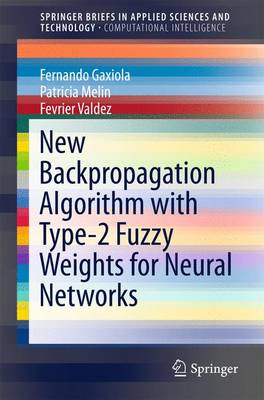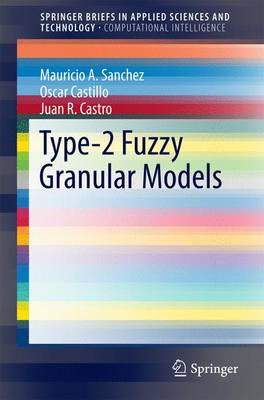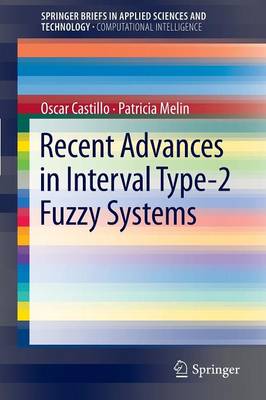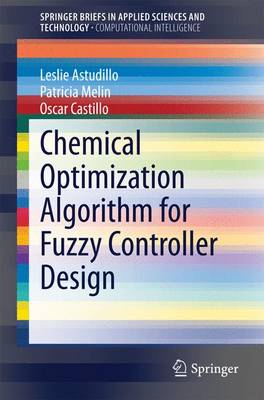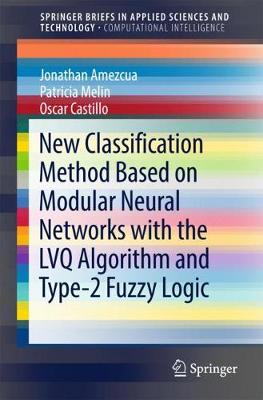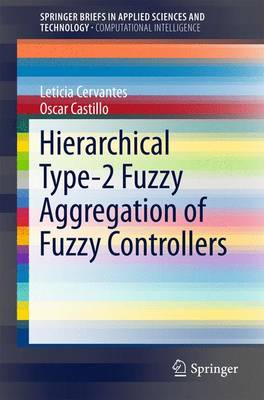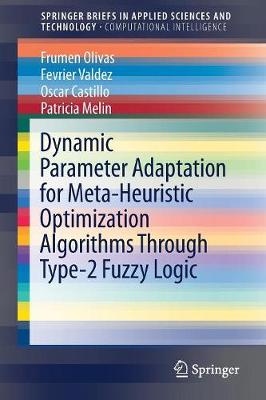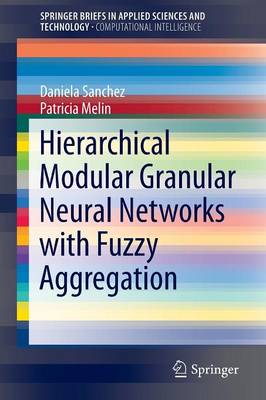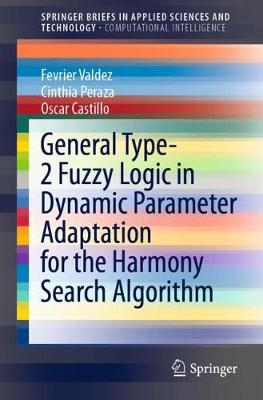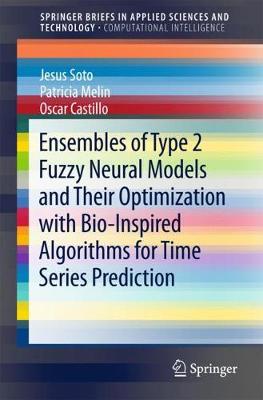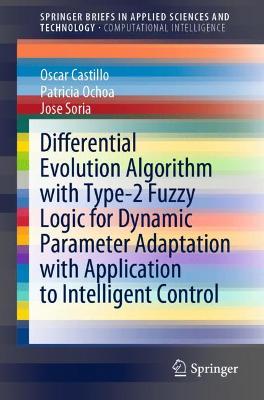SpringerBriefs in Applied Sciences and Technology
13 total works
New Backpropagation Algorithm with Type-2 Fuzzy Weights for Neural Networks
by Fernando Gaxiola, Patricia Melin, and Fevrier Valdez
Type-2 Fuzzy Granular Models
by Mauricio A. Sanchez, Oscar Castillo, and Juan R. Castro
In this book, a series of granular algorithms are proposed. A nature inspired granular algorithm based on Newtonian gravitational forces is proposed. A series of methods for the formation of higher-type information granules represented by Interval Type-2 Fuzzy Sets are also shown, via multiple approaches, such as Coefficient of Variation, principle of justifiable granularity, uncertainty-based information concept, and numerical evidence based. And a fuzzy granular application comparison is given as to demonstrate the differences in how uncertainty affects the performance of fuzzy information granules.
Recent Advances in Interval Type-2 Fuzzy Systems
by Oscar Castillo and Patricia Melin
Chemical Optimization Algorithm for Fuzzy Controller Design
by Leslie Astudillo, Patricia Melin, and Oscar Castillo
In this book, a novel optimization method inspired by a paradigm from nature is introduced. The chemical reactions are used as a paradigm to propose an optimization method that simulates these natural processes. The proposed algorithm is described in detail and then a set of typical complex benchmark functions is used to evaluate the performance of the algorithm. Simulation results show that the proposed optimization algorithm can outperform other methods in a set of benchmark functions.
This chemical reaction optimization paradigm is also applied to solve the tracking problem for the dynamic model of a unicycle mobile robot by integrating a kinematic and a torque controller based on fuzzy logic theory. Computer simulations are presented confirming that this optimization paradigm is able to outperform other optimization techniques applied to this particular robot application.
New Classification Method Based on Modular Neural Networks with the LVQ Algorithm and Type-2 Fuzzy Logic
by Jonathan Amezcua, Patricia Melin, and Oscar Castillo
In this book a new model for data classification was developed. This new model is based on the competitive neural network Learning Vector Quantization (LVQ) and type-2 fuzzy logic. This computational model consists of the hybridization of the aforementioned techniques, using a fuzzy logic system within the competitive layer of the LVQ network to determine the shortest distance between a centroid and an input vector. This new model is based on a modular LVQ architecture to further improve its performance on complex classification problems. It also implements a data-similarity process for preprocessing the datasets, in order to build dynamic architectures, having the classes with the highest degree of similarity in different modules. Some architectures were developed in order to work mainly with two datasets, an arrhythmia dataset (using ECG signals) for classifying 15 different types of arrhythmias, and a satellite images segments dataset used for classifying six different types ofsoil. Both datasets show interesting features that makes them interesting for testing new classification methods.
Hierarchical Type-2 Fuzzy Aggregation of Fuzzy Controllers
by Leticia Cervantes and Oscar Castillo
This book focuses on the fields of fuzzy logic, granular computing and also considering the control area. These areas can work together to solve various control problems, the idea is that this combination of areas would enable even more complex problem solving and better results. In this book we test the proposed method using two benchmark problems: the total flight control and the problem of water level control for a 3 tank system. When fuzzy logic is used it make it easy to performed the simulations, these fuzzy systems help to model the behavior of a real systems, using the fuzzy systems fuzzy rules are generated and with this can generate the behavior of any variable depending on the inputs and linguistic value. For this reason this work considers the proposed architecture using fuzzy systems and with this improve the behavior of the complex control problems.
Optimization of Type-2 Fuzzy Controllers Using the Bee Colony Algorithm
by Leticia Amador and Oscar Castillo
Edge Detection Methods Based on Generalized Type-2 Fuzzy Logic
by Claudia I. Gonzalez, Patricia Melin, Juan R. Castro, and Oscar Castillo
Another contribution in this book is that the generalized type-2 fuzzy edge detector method is applied in the preprocessing phase of a face rec-ognition system; where the recognition system is based on a monolithic neural network. The aim of this part of the book is to show the advantage of using a generalized type-2 fuzzy edge detector in pattern recognition applications.
The main goal of using generalized type-2 fuzzy logic in edge detec-tion applications is to provide them with the ability to handle uncertainty in processing real world images; otherwise, to demonstrate that a GT2 FS has a better performance than the edge detection methods based on type-1 and type-2 fuzzy logic systems.
Hierarchical Modular Granular Neural Networks with Fuzzy Aggregation
by Daniela Sanchez and Patricia Melin
In this book, a new method for hybrid intelligent systems is proposed. The proposed method is based on a granular computing approach applied in two levels. The techniques used and combined in the proposed method are modular neural networks (MNNs) with a Granular Computing (GrC) approach, thus resulting in a new concept of MNNs; modular granular neural networks (MGNNs). In addition fuzzy logic (FL) and hierarchical genetic algorithms (HGAs) are techniques used in this research work to improve results. These techniques are chosen because in other works have demonstrated to be a good option, and in the case of MNNs and HGAs, these techniques allow to improve the results obtained than with their conventional versions; respectively artificial neural networks and genetic algorithms.
General Type-2 Fuzzy Logic in Dynamic Parameter Adaptation for the Harmony Search Algorithm
by Fevrier Valdez, Cinthia Peraza, and Oscar Castillo
This book focuses on the fields of fuzzy logic and metaheuristic algorithms, particularly the harmony search algorithm and fuzzy control. There are currently several types of metaheuristics used to solve a range of real-world of problems, and these metaheuristics contain parameters that are usually fixed throughout the iterations. However, a number of techniques are also available that dynamically adjust the parameters of an algorithm, such as probabilistic fuzzy logic.
This book proposes a method of addressing the problem of parameter adaptation in the original harmony search algorithm using type-1, interval type-2 and generalized type-2 fuzzy logic. The authors applied this methodology to the resolution of problems of classical benchmark mathematical functions, CEC 2015, CEC2017 functions and to the optimization of various fuzzy logic control cases, and tested the method using six benchmark control problems – four of the Mamdani type: the problem of filling a water tank, the problem of controlling the temperature of a shower, the problem of controlling the trajectory of an autonomous mobile robot and the problem of controlling the speed of an engine; and two of the Sugeno type: the problem of controlling the balance of a bar and ball, and the problem of controlling control the balance of an inverted pendulum. When the interval type-2 fuzzy logic system is used to model the behavior of the systems, the results show better stabilization because the uncertainty analysis is better. As such, the authors conclude that the proposed method, based on fuzzy systems, fuzzy controllers and the harmony search optimization algorithm, improves the behavior of complex control plants.
Ensembles of Type 2 Fuzzy Neural Models and Their Optimization with Bio-Inspired Algorithms for Time Series Prediction
by Jesus Soto, Patricia Melin, and Oscar Castillo
This book focuses on the fields of hybrid intelligent systems based on fuzzy systems, neural networks, bio-inspired algorithms and time series. This book describes the construction of ensembles of Interval Type-2 Fuzzy Neural Networks models and the optimization of their fuzzy integrators with bio-inspired algorithms for time series prediction. Interval type-2 and type-1 fuzzy systems are used to integrate the outputs of the Ensemble of Interval Type-2 Fuzzy Neural Network models. Genetic Algorithms and Particle Swarm Optimization are the Bio-Inspired algorithms used for the optimization of the fuzzy response integrators. The Mackey-Glass, Mexican Stock Exchange, Dow Jones and NASDAQ time series are used to test of performance of the proposed method. Prediction errors are evaluated by the following metrics: Mean Absolute Error, Mean Square Error, Root Mean Square Error, Mean Percentage Error and Mean Absolute Percentage Error. The proposed prediction model outperforms state of the art methods in predicting the particular time series considered in this work.
This book focuses on the fields of fuzzy logic, bio-inspired algorithm, especially the differential evolution algorithm and also considering the fuzzy control area. The main idea is that these two areas together can help solve various control problems and to find better results. In this book, the authors test the proposed method using five benchmark control problems. First, the water tank, temperature, mobile robot, and inverted pendulum controllers are considered. For these 4 problems, experimentation was carried out using a Type-1 fuzzy system and an Interval Type-2 system. The last control problem was the D.C. motor, for which the experiments were performed with Type-1, Interval Type-2, and Generalized Type-2 fuzzy systems. When we use fuzzy systems combined with the differential evolution algorithm, we can notice that the results obtained in each of the controllers are better and with increasing uncertainty, the results are even better. For this reason, the authors consider in this book the proposed method using fuzzy systems and the differential evolution algorithm to improve the fuzzy controllers’ behavior in complex control problems.
